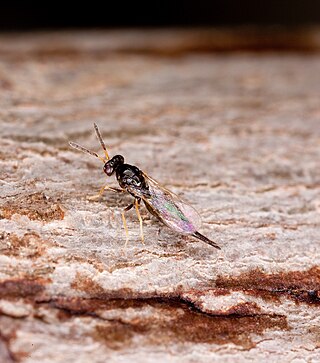
The Eulophidae is a large family of hymenopteran insects, with over 4,300 described species in some 300 genera. The family includes the genus Elasmus, which used to be treated as a separate family, "Elasmidae", and is now treated as a subfamily of Eulophidae. These minute insects are challenging to study, as they deteriorate rapidly after death unless extreme care is taken, making identification of most museum specimens difficult. The larvae of very few species feed on plants, but the majority are primary parasitoids on a huge range of arthropods at all stages of development. They are exceptional in that they are one of two hymenopteran families with some species that are known to parasitize thrips. Eulophids are found throughout the world in virtually all habitats.
Achrysocharoides is a genus of hymenopteran insects of the family Eulophidae.
Afrotroppopsis is a monotypic genus of hymenopteran insects of the family Eulophidae.
Aprostoporoides is a small Indomalayan genus of hymenopteran insects of the family Eulophidae which was described in 2004 with two newly described species from Kerala.
Baeoentedon is a genus of hymenopteran insects of the family Eulophidae, they are parasitoids of whitefly from the family Aleyrodidae which are found on trees of the genus Ficus. They have been recorded from Australia, China, India, Indonesia and Florida. A fifth species, Baeoentodon farazi, was described from Karnataka, India, in 2017.

Chrysocharis is a genus of hymenopteran insects of the family Eulophidae. Species in this genus are parasitoids as larvae, with hosts of multiple species being Agromyzidae flies.

Closterocerus is a genus of hymenopteran insects of the family Eulophidae.
Derostenus is a genus of hymenopteran insects of the family Eulophidae.
Eprhopalotus is a genus of hymenopteran insects of the family Eulophidae. Their distribution varies between species but ranges from Costa Rica, Mexico to Texas. There are currently 5 species of Eprhopalotus:
Goetheana is a genus of hymenopteran insects of the family Eulophidae. As a parasitoid of thrips, this wasp is used in biological pest control.

Horismenus is a genus of hymenopteran insects of the family Eulophidae occurring primarily in the Americas. As of 2015 over 400 species in the genus have been described. Horismenus species are often described as parasitizing other insects.
Microlycus is a genus of hymenopteran insects of the family Eulophidae.
Miotropis is a genus of hymenopteran insects of the family Eulophidae.

Omphale is a genus of hymenopteran insects of the family Eulophidae. It has cosmopolitan distribution.
Omphalentedon is a genus of hymenopteran insects of the family Eulophidae.

Pediobius is a genus of hymenopteran insects of the chalcid wasp family Eulophidae. Like their relatives, the larvae of these diminutive wasps are parasitoids of various arthropods. Some Pediobius are used in biological pest control.

Quadrastichus is a genus of hymenopteran insects of the family Eulophidae.

Sphenolepis is a genus of hymenopteran insects of the family Eulophidae.

Tetrastichinae is a subfamily of the chalcid wasp family Eulophidae. It is one of the largest subfamilies of the Eulophidae containing over 100 genera and nearly 3,000 species. The species of the family Tetrastichinae are found in almost any type of terrestrial habitat and have a worldwide distribution, except Antarctica. They show a varied biology and hosts for Tetrastichinae wasps have been identified from over 100 different insect families, across 10 different orders and they have also been recorded as being parasitoids on nematodes, mites and spiders' eggs. Some species are even phytophagous, while others are inquilines and yet others are gall formers.
Hakuna is a genus of chalcid wasps from the family Eulophidae, containing the only species Hakuna matata. It was named in 2006 from specimens reared from a plant gall collected in a forest in Uganda. H. matata was named after a catchphrase from Disney's 1994 animated film The Lion King (the phrase itself comes from the Swahili phrase Hakuna matata. It was thought that this naming would best convey "an African spirit".








